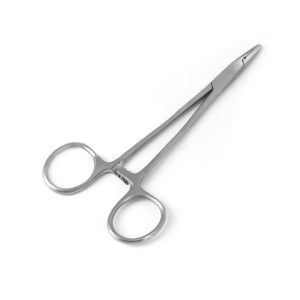The needle holder
As its name suggests, it carries the needle and thread that will load and suture the tissue or skin. The needle is pinched perpendicular to the crile wood needle holder and at the end of its jaws; gripping is usually two-thirds, one-third or one-half of the needle’s curvature and points to the left.
The claw dissecting forceps
It is used with the left hand for right-handed people as an aid to remove or present tissues or planes during a dissection. It allows, for example, turning well and presenting the skin to the needle which will load it perpendicularly.
The gripper without claw
It allows a finer but less strong grip. It is useful for the extraction of foreign bodies, but it is paradoxically more traumatic than the claw forceps for the skin.
The scalpel
It is only used for the incision of the skin and subcutaneous tissue. It is a bad instrument for dissection, because it is imprecise and blunt. It can possibly be used to cut the superficial threads in the absence of suitable scissors.
The dissecting chisel
It is the main instrument for dissecting anatomical planes during procedures such as hernias, hydrocele, and ablation of cysts or lipomas. These small scissors must not cut large tendons or Apo neuroses, and even less threads, even catguts because very quickly, they will take play in the central axis and lose their precision and their bevel.
Stronger scissors are allowed to do what previous scissors prohibited. We do not dissect with straight scissors, but they are used, for example, to cut the intestine during a resection. Good, curved, sharp Mayo scissors can dissect properly during hernia repair, for example.
The first use of the hemostasis forceps is to allow, by a fine grip, the ligature of a vessel or its coagulation by the electric scalpel.
It is also a good complement in the location and tensioning of tissues during dissection, on an apo neurosis, a hernial sac, a hydrocele vaginal.
Finally, as a marker clamp on past and pending wires; typical case of the threads of the digestive suture or the repair of the wall after a hernia cure, which are not tied until all have been passed.
Classically straight and cheerful, the Kocher forceps do not allow fine haemostasis but allow strong traction on certain tissues. The gripping of the ends of the tendons and nerves to be sutured is prohibited with the dissecting and hemostatic forceps. It is best to locate the tendon with a wire to exert traction and present it, or to fix it to the underlying osteotendinous plane with an intramuscular needle (typical case for the flexor tendons of the hand).
The curette removes necrotic tissue and debris well after incision of abscess; likewise, in the vicinity of a recent contuse wound or an infected wound, the dead tissue is eliminated with a curette while the still living tissue resists.
Postoperatively, the fluted probe is an “explorer” of the recent wound, between two threads, where a collection of pus is suspected. She also explores all the wounds to judge their depth and extent.
The pair of Farabeuf retractors is the essential complement during an intervention. It is entrusted to the helper under the direction of the operator to remove superficial tissue when the surgeon is working in depth.
The gripping of the flat internal organs can be done with the heart forceps, but with gentle, non-traumatic gripping, the fingers in the rings of the forceps without closing or blocking the rack, if the organs remain in place and are simply manipulated (example: intestine and cecum during appendectomy). On the other hand, if the organs “fall”, the rack can be closed to a notch or completely (appendix, intestinal resection, colectomy, gastrectomy, lipoma).
For more details, please visit: jimymedical.co.uk
